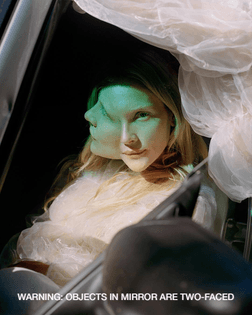A Cyborg Manifesto - Wikipedia
https://en.wikipedia.org/wiki/A_Cyborg_Manifesto
“In it, the concept of the cyborg is a rejection of rigid boundaries, notably those separating "human" from "animal" and "human" from "machine". She writes: "The cyborg does not dream of community on the model of the organic family, this time without the oedipal project. The cyborg would not recognize the Garden of Eden; it is not made of mud and cannot dream of returning to dust."[1]”
“Evolution has blurred the lines between human and animal; 20th century machines have made ambiguous the lines between natural and artificial; and microelectronics and the political invisibility of cyborgs have confused the lines of physicality.[1]”
“She highlights specific problematic dualisms of self/other, culture/nature, male/female, civilized/primitive, right/wrong, truth/illusion, total/partial, God/man (among others). She explains that these dualisms are in competition with one another, creating paradoxical relations of domination (especially between the One and the Other). However, high-tech culture provides a challenge to these antagonistic dualisms.”
user:programmer
“Cyborg theory relies on writing as "the technology of cyborgs," and asserts that "cyborg politics is the struggle for language and the struggle against perfect communication, against the one code that translates all meaning perfectly, the central dogma of phallogocentrism."”
“As Haraway explains, "grammar is politics by other means," and effective politics require speaking in the language of domination.”
“Feminist cyborg stories have the task of recoding communication and intelligence to subvert command and control.”
“" These stories are "communications devices" which "can suggest a way out of the maze of dualisms in which we have explained our bodies," dualisms which engender the illusion of perfect coded communication. Haraway mentions Octavia Butler, John Varey, and Vonda McIntyre as authors/artists whose work constitute a feminist science fiction of cyborg stories”
“the unified human subject of identity has shifted to the hybridized posthuman of technoscience, from "representation" to "simulation", "bourgeois novel" to "science fiction", "reproduction" to "replication", and "white capitalist patriarchy" to "informatics of domination".[1]”
“Haraway's "ironic dream of a common language" is inspired by Irigaray's argument for a discourse other than patriarchy, she rejects Irigaray's essentializing construction of woman-as-not-male to argue for a linguistic community of situated, partial knowledges in which no one is innocent.”
“The views of traditional feminism operate under the totalizing assumptions that all men are one way, and women another, whereas "a cyborg theory of wholes and parts," does not desire to explain things in total theory. Haraway suggests that feminists should move beyond naturalism and essentialism, criticizing feminist tactics as "identity politics" that victimize those excluded, and she proposes that it is better strategically to confuse identities.”
“The former, she writes, achieves "to expand the category of labour to what (some) women did". Socialist feminism does not naturalize but rather builds a unity that was non-existent before-namely the woman worker.”
“The concept of woman is socially constructed within the patriarchal structure of society and women only exist because men have made them exist. The woman as a self does not exist. Haraway criticizes both when writing that "my complaint about socialist/Marxian standpoints is their unintended erasure of polyvocal, unassimilable, radical difference made visible in anti-colonial discourse and practice" and "MacKinnon's intentional erasure of all difference through the device of the 'essential' non-existence of women is not reassuring" (299).[1]”
“woman of color "might be understood as a cyborg identity, a potent subjectivity synthesized from fusions of outsider identities and in the complex political-historical layerings of her 'biomythography.'"[1]”
“Cyborgs might consider more seriously the partial, fluid, sometimes aspect of sex and sexual embodiment. Gender might not be global identity after all, even if it has profound historical breadth and depth."”
“Haraway also calls for a reconstruction of identity, no longer dictated by naturalism and taxonomy but instead by affinity, wherein individuals can construct their own groups by choice. In this way, groups may construct a "post-modernist identity out of otherness, difference, and specificity" as a way to counter Western traditions of exclusive identification.”
“She acknowledges that her argument in the "Manifesto" seeks to challenge the necessity for categorization of gender, but does not correlate this argument to post-genderism. She clarifies this distinction because post-genderism is often associated with the discourse of the utopian concept of being beyond masculinity and femininity. Haraway notes that gender constructs are still prevalent and meaningful, but are troublesome and should therefore be eliminated as categories for identity.[3]”
“Patchwork Girl, a hypertext work, makes use of elements from "A Cyborg Manifesto". Patchwork Girl's "thematic focus on the connections between monstrosity, subjectivity, and new reproductive technologies is apparent from its very first page, when readers, or users, open the hypertext to find a picture of a scarred and naked female body sewn together with a single dotted line...Readers enter the text by clicking on this body and following its 'limbs' or links to different sections of the text."[5”
“In Jackson's narrative, the Patchwork Girl is an aborted female monster created by Victor Frankenstein of Mary Shelley's 1818 novel Frankenstein, or The Modern Prometheus, an abhorrent and monstrous creature that is "part male, part female, part animal, 175 years old, and 'razed' up through hypertext technology."[5]”
“The Patchwork Girl embraces Haraway's conception of a cybernetic posthuman being in both her physical multiplicity and her challenge towards "the images and fantasies sustaining reproductive politics."[5]”
“Turkish critical scholar Leman Giresunlu uses Haraway's cyborg as framework to examine current science fiction movies such as Lara Croft: Tomb Raider and Resident Evil in her essay "Cyborg Goddesses: The Mainframe Revisited".[6] In this essay, she explores how her new concept of the cyborg goddess, a female figure "capable of inflicting pain and pleasure simultaneously", can be used to make sense of how female representation is shifting towards a more multidimensional stance. Giresunlu builds from Haraway's cyborg because the cyborg goddess goes beyond "offering a way out from [the] duality" and instead provides how spirituality and technology work together to form a complex and more accurate representation of women”
“The rapid adoption of the article in academic circles also increased the pace of the critical conversation surrounding the work, and in 1990, Haraway felt that the essay had "acquired a surprise half life," which made it "impossible to rewrite" and necessitated revisiting the topic in her subsequent publications.[11]”
“Criticism and controversy were built into the essay's publication history: the East Coast Collective of the Socialist Review found the piece "a naive embrace of technology" and advocated against its publication, while The Berkeley Collective ultimately insisted that it go to print”
“Critiques[16] of Haraway have also centered on the accessibility of the thematic topics she discusses in her writing, and according to third-wave feminist readings, her work "assumes a reader who is familiar with North American culture," and posits that "readers without the appropriate cultural capital are...likely to find it infuriatingly obscure and impenetrable”
“Wajcman also argues that Haraway's view of technology in "A Cyborg Manifesto" is perhaps too totalizing, and that the binary of "the cyborg solution and the goddess solution" ultimately "caricatures feminism" by focusing too readily on a dichotomy that may in fact be a false one.[15]”
“what she in fact offers is a further legitimation for buying into the not so new American civil religion of high technology.”
“Scholar Marilyn Maness Mehaffy writes that the "sonographic fetus is in many ways the ultimate cyborg in that it is 'created' in a space of virtuality that straddles the conventional boundary between an organic body and a digital text.”
“We know that fetal images are depictions, yet the sonogram invokes a documentary-like access to fetuses that makes it easy to ignore this, which in turn can limit the authority and agency of pregnant women."[5] In positioning the fetus as independent, and consequently oppositional, to the pregnant mother, these reproductive technologies "reinscribe stable meanings to the human/machine dualism they supposedly disrupt."[5] Valerie Hartouni argues, "most reproductive technologies have assimilated into the 'order of nature'"[26] which would make Haraway's vision of a regenerative species, unrestricted by heteronormative conceptions of reproduction, unattainable in the sonographic fetus.”








